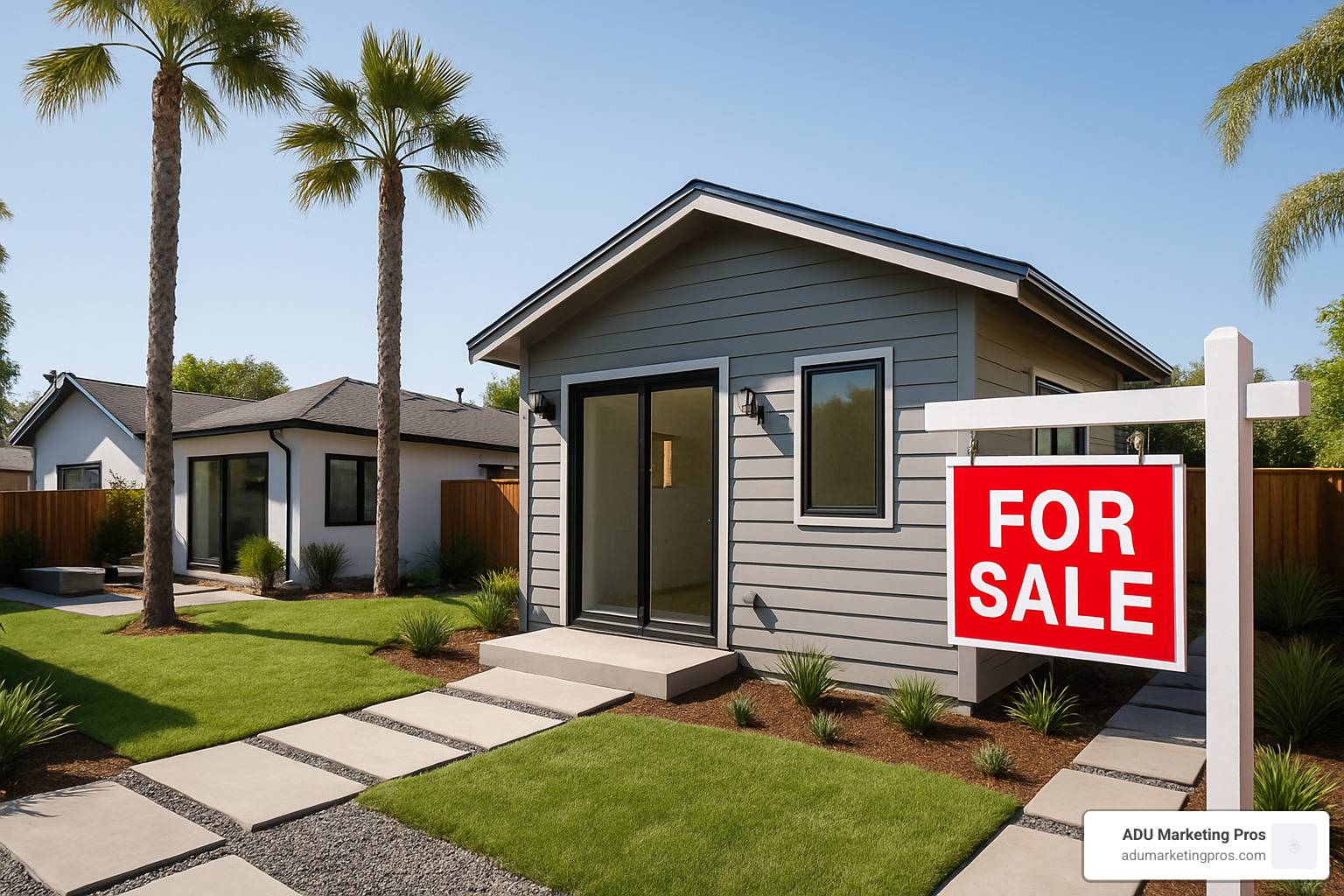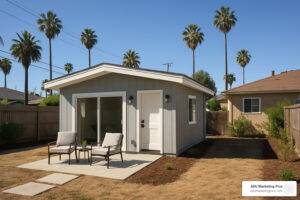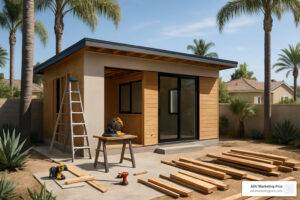Why San Jose ADU Marketing is Exploding Right Now
San Jose ADU marketing has become a hot topic as the city leads California in groundbreaking housing policies. With over 460 ADU permits issued in 2023 alone and the nation’s first law allowing ADU condo sales, San Jose presents unique opportunities for builders, architects, and marketers.
The change happening in San Jose’s housing landscape represents more than just policy changes—it’s a fundamental shift in how we think about urban density, homeownership, and wealth building. For marketing professionals in the ADU space, this creates an unprecedented opportunity to position their services at the forefront of a housing revolution.
Key San Jose ADU Marketing Opportunities:
– Condo Sales: First city allowing separate ADU sales as condos (AB 1033)
– Strong Demand: 460+ permits in 2023, up from 330 in 2020
– Rental Income: $1,500-$3,000/month potential
– Fast Builds: 90-day prefab installations with pre-approved plans
– Cost Advantage: ADUs cost $250k-$350k vs. $725k median condo price
San Jose’s housing crisis creates perfect conditions for ADU growth. The average home costs nearly $1.5 million while median household income sits at $133,835. This massive gap drives homeowners to explore ADUs for rental income and wealth building. The city’s tech-heavy economy means many residents have substantial home equity but need additional income streams to maintain their lifestyle in one of America’s most expensive markets.
The demographic trends supporting ADU growth are particularly compelling. San Jose has a large population of aging homeowners who want to age in place while generating income from their properties. Simultaneously, the city attracts young professionals who can’t afford traditional homeownership but have stable incomes that support ADU condo purchases. This creates a perfect storm of supply and demand that savvy marketers can leverage.
The city has built more than 1,400 new ADUs since 2019, contributing over 20% of new housing stock. Mayor Sam Liccardo’s administration streamlined permitting and launched a 0% interest loan pilot program, making ADUs more accessible than ever. These policy innovations didn’t happen by accident—they represent a deliberate strategy to address housing shortages through innovative zoning and financing approaches.
For marketers in the ADU space, San Jose offers a unique value proposition. You’re not just selling backyard units—you’re selling standalone condominiums that buyers can own with their own title. This changes everything about how you position and market these properties. Instead of competing solely on construction quality or price, you can emphasize wealth-building potential, homeownership opportunities, and long-term financial security.
The regulatory environment continues to evolve in favor of ADU development. Recent changes to state law have preempted many local restrictions that previously made ADU development difficult or impossible. San Jose has acceptd these changes more enthusiastically than most cities, creating a business-friendly environment for ADU developers and the marketing professionals who serve them.

Quick San Jose ADU marketing definitions:
– ADU building costs
– Energy-efficient ADU
– Multi-generational ADU
Why ADUs Are a Game-Changer in San Jose
San Jose’s housing crisis isn’t just a statistic—it’s a daily reality for thousands of families. With over 6,300 people experiencing homelessness and homebuyers needing incomes above $450,000 just to qualify for a mortgage, the city desperately needs creative housing solutions. That’s where ADUs step in as true game-changers.
The numbers paint a remarkable picture of growth. California added 22,802 ADUs in 2023, representing one in every five new homes built statewide. San Jose leads this movement with 460 permits issued in 2023 alone, building on the 1,400+ units completed since 2019. For anyone involved in San Jose ADU marketing, these trends represent unprecedented opportunity.
What makes San Jose’s ADU boom particularly significant is the quality and thoughtfulness of the development. Unlike some cities where ADUs are afterthoughts or poorly designed additions, San Jose has emphasized creating livable, attractive units that improve rather than detract from neighborhood character. This focus on quality creates marketing opportunities that emphasize community benefits alongside individual financial gains.
The city’s approach to ADU regulation reflects a sophisticated understanding of urban planning challenges. By allowing various ADU types while maintaining reasonable size limits and setback requirements, San Jose has created a framework that works for diverse neighborhoods and property types. This regulatory clarity makes it easier for builders to plan projects and for marketers to communicate realistic timelines and costs to potential clients.
What makes ADUs so appealing is their flexibility. Whether you’re building a detached ADU up to 1,000 square feet (or 1,200 on larger lots), an attached unit connected to your main house, or a Junior ADU under 500 square feet that can share bathroom facilities, there’s an option for almost every property and budget.
The economic impact of ADU development extends beyond individual property owners. Local contractors, architects, and suppliers have built thriving businesses around ADU construction. This ecosystem creates natural partnership opportunities for marketing professionals who understand how to connect different players in the ADU development process.
The city has removed many traditional barriers that made housing development difficult. You don’t need a minimum lot size, parking isn’t required within half a mile of public transit, and the 4-foot setback requirement keeps things simple. Most importantly, the streamlined 60-day permit process means you can move from plans to construction quickly.
Environmental considerations also support ADU development in San Jose. By increasing density within existing neighborhoods, ADUs reduce pressure for suburban sprawl and help preserve open space and agricultural land. This environmental benefit resonates with many San Jose residents who prioritize sustainability and smart growth principles.
But here’s where things get really exciting for San Jose homeowners and the San Jose ADU marketing landscape.

How the New Condo Law (AB 1033) Works
On July 18, 2024, San Jose made housing history. The city became the first in California to implement AB 1033, a law that completely transforms how we think about ADUs. Instead of just renting out your backyard unit, you can now sell it as a separate condominium with its own title.
This isn’t just a minor policy tweak—it’s a fundamental shift that opens entirely new possibilities for wealth building and homeownership access. The law represents years of advocacy by housing experts who recognized that traditional approaches to affordable housing weren’t keeping pace with demand.
The process works through HOA formation, where homeowners create a homeowners association that governs both the main house and the ADU. The ADU then receives its own deed and separate title, making it independently owned while keeping the original property as one parcel. Unlike lot splits that divide land, this approach maintains the neighborhood’s character while creating two distinct ownership opportunities.
The legal framework supporting condo conversions required careful consideration of property rights, financing mechanisms, and buyer protections. State legislators worked closely with real estate professionals, lenders, and consumer advocates to create a system that protects all parties while enabling new forms of homeownership.
Buyer protections mirror those of traditional condominiums, including standard disclosure requirements and financing options. The Federal Housing Administration has expanded construction loan eligibility to include homes with existing or planned ADUs, making financing more accessible than ever before.
For anyone in the San Jose ADU marketing space, this law creates an entirely new product category to promote and sell. The marketing implications are profound—you’re no longer just selling construction services, but rather complete wealth-building solutions that can transform families’ financial futures.
Benefits & Trade-Offs for Homeowners, Buyers, Community
The condo conversion option creates what many call a “wealth event” for homeowners. Picture this: you spend $250,000 to $350,000 building an ADU, then sell it as a condo for potentially $832,000 based on San Jose’s current median price per square foot. That’s serious equity creation without having to sell your primary home.
For buyers, ADU condos offer a realistic path to homeownership in one of America’s most expensive markets. While a median single-family home costs about $1.4 million, ADU condos provide smaller, more affordable entry points into established neighborhoods with character and amenities.
The buyer demographic for ADU condos is particularly interesting from a marketing perspective. These aren’t just first-time homebuyers—they include downsizing empty nesters, young professionals who prioritize location over space, and investors looking for cash-flowing properties in prime locations. Understanding these diverse buyer motivations helps marketers craft more effective campaigns.
The community wins through “naturally occurring affordable housing”—smaller homes sprinkled throughout existing neighborhoods without the massive infrastructure costs of new developments. This approach preserves neighborhood character while addressing the housing shortage through thoughtful infill.
Neighborhood integration has been a key focus of San Jose’s ADU policies. By maintaining design standards and size limits, the city ensures that ADUs complement rather than overwhelm existing housing stock. This thoughtful approach has reduced neighborhood opposition and created more opportunities for successful ADU development.
Impact fees are waived for units under 750 square feet, making smaller ADUs particularly attractive from a cost perspective. However, larger units face additional fees that need factoring into your financial planning.
The trade-offs deserve honest consideration. Homeowners must steer HOA formation and ongoing dues, which adds complexity and monthly costs. There’s also risk around converting illegal existing units, as the process could expose code violations that require expensive corrections.
Some real estate professionals note that while ADUs generally increase overall property value, primary homes might see slight decreases from having new, close neighbors. The key is weighing the rental income potential of $1,500 to $3,000 monthly or the equity from condo sales against these considerations.
Long-term maintenance and management considerations also factor into the equation. ADU owners need to plan for ongoing upkeep, potential vacancy periods, and the responsibilities that come with being landlords or HOA members. These practical considerations create opportunities for service providers and marketing professionals who can offer comprehensive solutions.
For the San Jose ADU marketing professional, understanding these nuanced benefits and trade-offs helps create more honest, effective campaigns that set realistic expectations while highlighting genuine opportunities.
San Jose ADU Marketing Strategies That Work
When it comes to San Jose ADU marketing, copy-and-paste tactics from Los Angeles or Austin flop. San Jose homeowners face $1.5 million median prices, tech salaries, and the brand-new condo-sale law. Speak to that context or be ignored.
The winning formula mixes hyper-local targeting with education. Tell stories about wealth building and multi-generational living, and back them up with San Jose data and social proof. Residents here expect polished digital tools, clear timelines, and total transparency.
More info about ADU Digital Marketing Strategies
Local SEO Tactics for “San Jose ADU marketing”
San Jose searches look like “Willow Glen ADU permits” or “ADU condo sales San Jose,” not just “ADU builder.” Optimise your Google Business Profile, add LocalBusiness and Service schema, and build neighborhood pages such as “Almaden Valley ADU builder”. Earn links from the San Jose Chamber of Commerce and Houzz, then request reviews that mention permit speed or rental income.
More info about Local SEO Services San Jose
Content & Lead Generation for “San Jose ADU marketing”
Interactive tools—cost calculators that include city fees, webinars on “AB 1033 condo sales,” and virtual tours of completed projects—convert best. Case studies with exact timelines (“50-day permit, $2,800 rent”) build trust. Gate a “Complete Guide to San Jose ADU Development” to capture emails.
More info about ADU Lead Generation

Partnering with Prefab Builders & Lenders
Team up with prefab firms offering 90-day installs and lenders who understand FHA ADU loans. Co-marketing lets you reach both homeowners and ADU-condo buyers while offering a turnkey solution. Spotlight San Jose’s 0 % interest loan pilot to create urgency.
Building & Selling Your ADU: Cost, Timeline, Permits
Most detached ADUs in San Jose cost $250,000–$350,000 and clear permits in about 60 days. Stick-built projects finish in 4-9 months, while prefab units can be renting—or selling—in roughly five months (permit + 90-day build).
More info about Pre-Approved ADU Plans San Jose

Step-by-Step Permit Checklist
• No minimum lot size
• 4-ft side/rear setbacks
• Detached up to 1,000 sq ft (1,200 sq ft on 9,000 sq ft lots)
• JADU ≤ 500 sq ft
• No parking required within ½ mile of transit
• Build within 1 year of permit
Extra reviews apply in flood, WUI, or historic zones, but using the city’s pre-approved plans often cuts weeks off approval.
Financing & ROI Snapshot
Options include the city’s 0 % bridge loan, HELOCs, cash-out refis, and new FHA-backed construction loans. Rents of $1,500–$3,000 can offset payments, or owners can sell the unit as a condo—e.g., a $300k build selling near $832k. Remember to budget for HOA formation and dues if you choose the condo route.
Expert Roundup: Voices from the Field
Builders say the 90-day prefab timeline is a “conversation changer.” Architects design sub-750-sq-ft units to dodge impact fees. Real-estate agents call AB 1033 “a brand-new product category” that demands extra buyer education on HOAs and shared utilities. Policy advocates interviewed by KTVU see ADUs as “naturally occurring affordable housing” that respects neighborhood character.
Key Takeaways for Marketers
- Sell expertise, not discounts—permit confidence beats lowest bid.
- Lead with compliance messaging; homeowners fear red-tag fines.
- Tell community stories—ADUs keep families close and add gentle density.
- Use local data (permit timelines, rental comps) instead of statewide averages.
Frequently Asked Questions about San Jose ADU Marketing
What makes San Jose different for ADU marketing?
It’s the first U.S. city where owners can sell an ADU as a condo. Combine that with 60-day permits, pre-approved plans, and a 0 % city loan and you have a message competitors can’t copy.
How long does it take to build and sell an ADU here?
Prefab: ~5 months (60-day permit + 90-day build). Custom: 8-12 months. Condo sales add 1-2 months for HOA and title work.
Can I market my ADU before permits are final?
Yes—just disclose that the sale or lease is contingent on final approval. Many owners build a waiting list during construction, especially when using pre-approved plans.
Conclusion
The future of San Jose ADU marketing looks incredibly bright. We’re witnessing the birth of something truly special—a housing solution that tackles affordability while creating real wealth for families. San Jose didn’t just stumble into this opportunity; the city deliberately crafted policies that make ADUs work for everyone.
Think about it: where else can you build a $300,000 unit and potentially sell it for over $800,000? The math is compelling, but the human stories matter even more. We’re seeing grandparents move closer to grandchildren, young adults find their first path to homeownership, and families find financial breathing room in an expensive city.
The AB 1033 condo sales law changes everything about how we market these properties. Instead of pitching “rental income,” we’re now selling “homeownership dreams.” That shift opens up entirely new audiences and marketing messages that simply didn’t exist before July 2024.
For builders and architects, San Jose offers a testing ground for innovative approaches. The city’s willingness to experiment with streamlined permits, pre-approved plans, and zero-percent financing creates conditions you won’t find anywhere else. Early movers who master this market will have advantages that become harder to replicate as competition increases.
We expect other California cities to follow San Jose’s lead, but being first matters. The contractors, architects, and marketers who perfect their approach here will be ready to expand as new markets open up. That’s why getting your San Jose ADU marketing strategy right now feels so important.
The community benefits extend far beyond individual projects. Every new ADU adds housing without sprawling into farmland or forcing long commutes. These units create naturally occurring affordable housing sprinkled throughout established neighborhoods, maintaining character while increasing options.
Looking ahead, we see even more opportunities emerging. As financing options expand and construction methods improve, ADUs will become accessible to more homeowners. The wealth-building potential through condo sales could help families build generational equity in ways that seemed impossible just a few years ago.
At ADU Marketing Pros, we’re passionate about helping our clients succeed in this dynamic market. Our specialized approach to San Jose ADU marketing combines deep local knowledge with proven digital strategies that actually work. We understand the unique challenges and opportunities in this space because we live and breathe it every day.
Ready to turn your ADU expertise into marketing success? More info about ADU Marketing Solutions and find how we can help you build a thriving ADU business in San Jose’s exciting market.





